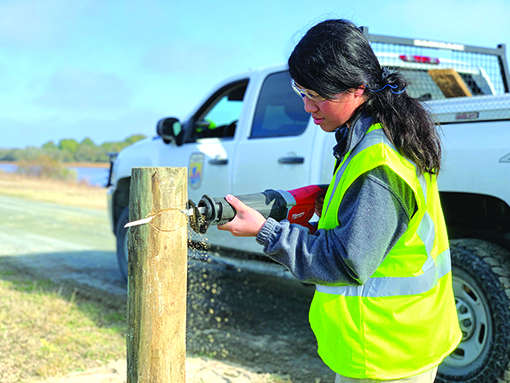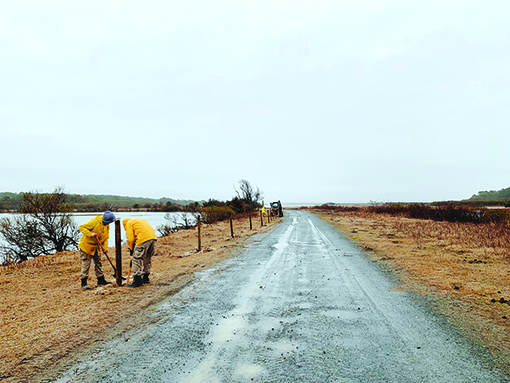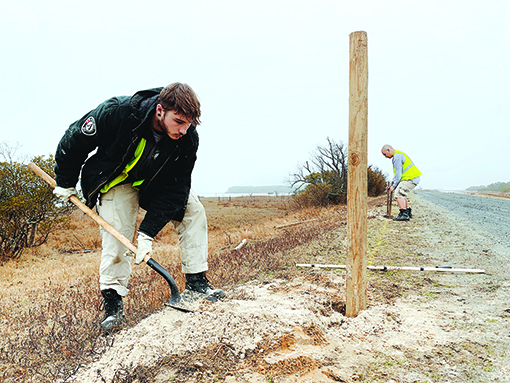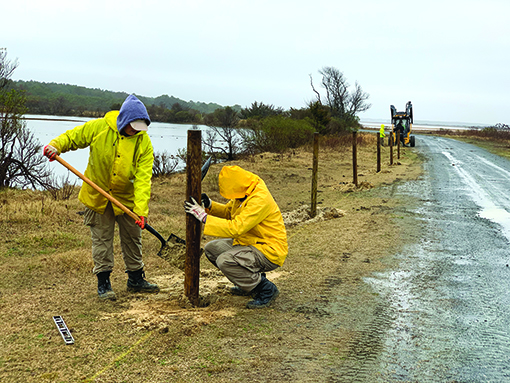
By Carol Vaughn
Submitted Photos
A team of seven young adults from around the country is installing fencing on Assateague as part of an AmeriCorps program.
The fence is to keep the Chincoteague ponies that live on the island from grazing in the salt marsh in the northern section of Chincoteague National Wildlife Refuge.
“There have been some segments of salt marsh that have been overgrazed. Coupled with sea-level rise and storm surge, it has caused the salt marsh to degrade — so we are trying to protect those areas, so that we can have it restored,” said Nancy Finley, refuge manager.

The project includes replacing 17 miles of fence along the service road.
The old fence was galvanized barbed wire. The new one is a barbless, plastic-coated galvanized wire that should last about 20 years, Finley said.
The Delta 3 Team of AmeriCorps’ National Civilian Community Corps has been together since July. It is based in Vicksburg, Mississippi, the program’s southern region campus.
The seven arrived Jan. 10 at the Chincoteague refuge and will remain until mid-February.
This is their third round of projects for nonprofit organizations.
They have helped with Hurricane Michael recovery in Panama Beach, Fla., and completed a second round split between a flood recovery project in West Virginia and working at a family center in Kentucky.
Lindsey Hubbell, 20, of Pocohantas, Iowa, said the fence project is unique in her Americorps experience.

“We haven’t really done environmental stuff or worked with animals,” she said. They are not working directly with the ponies, but the animals sometimes come near, seemingly curious about their work.
The group stays in a bunkhouse on the refuge.
Although winter is a quiet time on Chincoteague, the seven already have checked out local businesses — including Sundial Books, Flying Fish gallery, Don’s Seafood, and H & H Pharmacy, among others.
They also spoke at Chincoteague High School about Americorps, and plan to speak to students at Arcadia High School, as well.
Additionally, members are looking for independent volunteer work to help complete their program requirement of 80 hours, which is in addition to the team projects.
To contact team members about volunteer opportunities on or near Chincoteague while they are here, email Elise McAuliffe at [email protected].
The Chincoteague Volunteer Fire Company plans to have a workday with the team on the fence project in February, Finley said.

None of the seven had visited Chincoteague before.
Getting to see different parts of the country is among the benefits of the program.
“I had not been to a lot of states before,” Hubbell said.
Additionally, project sponsors sometimes offer volunteers a job after their AmeriCorps service is completed.
McAuliffe, 19, of Indiana, is considering returning to the family center in Kentucky after she graduates from the program.
“It was really awesome working there. I’m interested in social work, so it was a good match,” she said.
Everyone on the team has graduated from high school and two, Zach Hernandez and Sabrina Johnkins, have finished college. AmeriCorps participants also can earn a GED during their service if they did not graduate from high school.
AmeriCorps is a good gap year experience for some youth and helps others gain experience and build skills, according to team members.
“It also looks great on a resume,” said Hernandez, of Eugene, Ore., who recently turned 25.

“For those who have taken a gap year, this is a great way to not jump into college right away and spend all that money, if you are not sure what you want to do — you kind of get a feel for what you are interested in by getting real-life experience,” said Johnkins, 23, of Green Bay, Wis.
“I’ve had really good luck with AmeriCorps (participants) over the years I have worked with them,” Finley said, calling them dedicated and hard workers.
She especially likes “the idea of getting younger folks interested in some of the things we are doing” at the refuge.
“Managing a wildlife refuge is just one job, and you wouldn’t, maybe, have known about it if you had not come here,” she said to the group.
About AmeriCorps

AmeriCorps, a network of national service programs, includes three programs that each take a different approach to improving lives and fostering civic engagement, according to the website, https://www.nationalservice.
NCCC is a full-time, residential, team-based program for adults ages 18 to 24. Participants serve for 10 months, or 11 months for team leaders.
To graduate, participants must complete 1,700 hours of team service and 80 hours of independent volunteer projects.
Participants receive an award of around $6,000 to help pay for education, along with a stipend, and money for food and travel expenses.


